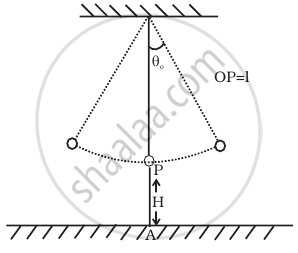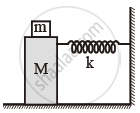Advertisements
Advertisements
प्रश्न
A body of mass m is situated in a potential field U(x) = U0 (1 – cos αx) when U0 and α are constants. Find the time period of small oscillations.
उत्तर
Given the potential energy associated with the field
U(x) = U0 (1 – cos αx) [∵ For conservative force f, we can write f = `(-du)/(dx)`] ......(i)
Now, Force F = `- (dU(x))/(dx)` .....[We have assumed the field to be conservative]
F = `- d/(dx) (U_0 - U_0 cos ax) = - U_0 a sin ax`
F = `- U_0 a^2x` [∵ For small oscillations ax is small, sin ax ≈ ax] ......(ii)
⇒ F ∝ (– x)
As, U0, a being constant.
∴ Motion is S.H.M for small oscillations.
The standard equation for S.H.M F = `- mω^2x` ......(iii)
Comparing equations (ii) and (iii), we get
`mω^2 = U_0a^2`
`ω^2 = (U_0a^2)/m` or `ω = sqrt((U_0a^2)/m)`
∴ Time period T = `(2pi)/ω = 2pi sqrt(m/(U_0a^2))`
APPEARS IN
संबंधित प्रश्न
If the metal bob of a simple pendulum is replaced by a wooden bob of the same size, then its time period will.....................
- increase
- remain same
- decrease
- first increase and then decrease.
The acceleration due to gravity on the surface of moon is 1.7 ms–2. What is the time period of a simple pendulum on the surface of moon if its time period on the surface of earth is 3.5 s? (g on the surface of earth is 9.8 ms–2)
Define practical simple pendulum
A simple pendulum has a time period of T1 when on the earth's surface and T2 when taken to a height R above the earth's surface, where R is the radius of the earth. The value of `"T"_2 // "T"_1` is ______.
The period of oscillation of a simple pendulum of constant length at the surface of the earth is T. Its time period inside mine will be ______.
A particle executing S.H.M. has a maximum speed of 30 cm/s and a maximum acceleration of 60 cm/s2. The period of oscillation is ______.
When will the motion of a simple pendulum be simple harmonic?
A cylindrical log of wood of height h and area of cross-section A floats in water. It is pressed and then released. Show that the log would execute S.H.M. with a time period. `T = 2πsqrt(m/(Apg))` where m is mass of the body and ρ is density of the liquid.
A simple pendulum of time period 1s and length l is hung from a fixed support at O, such that the bob is at a distance H vertically above A on the ground (Figure). The amplitude is θ0. The string snaps at θ = θ0/2. Find the time taken by the bob to hit the ground. Also find distance from A where bob hits the ground. Assume θo to be small so that sin θo = θo and cos θo = 1.

In the given figure, a mass M is attached to a horizontal spring which is fixed on one side to a rigid support. The spring constant of the spring is k. The mass oscillates on a frictionless surface with time period T and amplitude A. When the mass is in equilibrium position, as shown in the figure, another mass m is gently fixed upon it. The new amplitude of oscillation will be:

